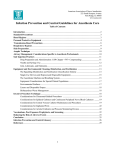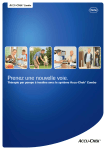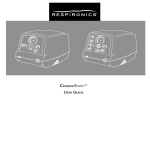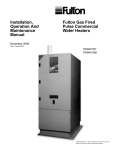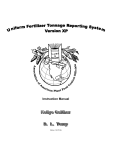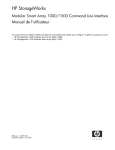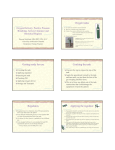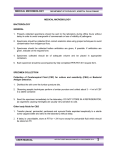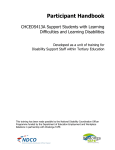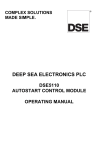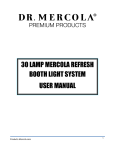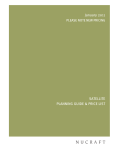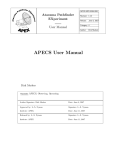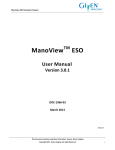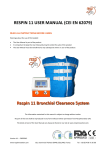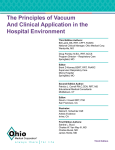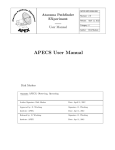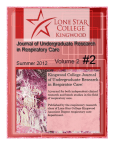Download The MetaNeb® System
Transcript
1/30/2014 The MetaNeb® System For the Treatment & Prevention of Atelectasis and Retained Secretions Page ©2013 Hill‐Rom Services, PTE Ltd. ALL RIGHTS RESERVED Disclosures • • • • Anne Snyder, RRT Clinical Education Specialist Respiratory Health Division; Hill‐Rom® Makers of; – The MetaNeb® System – The Vest® Airway Clearance System Page 2 ©2013 Hill‐Rom Services, PTE Ltd. ALL RIGHTS RESERVED The MetaNeb® System Presentation Objectives 1. Identify conditions and patient populations at risk for pulmonary complications 2. Discuss challenges to providing airway clearance and lung expansion therapy 3. Understand the mechanisms of action of The MetaNeb® System 4. Gain insight into which patients in the hospital may benefit from MetaTherapy® Treatments 5. Review sample literature Page Page 3 ©2013 Hill‐Rom Services, PTE Ltd. ALL RIGHTS RESERVED 3 1 1/30/2014 Factors that Affect Airway Clearance Impaired mucociliary clearance • Artificial airways/mechanical ventilation • Thick and/or hypersecretions • Immobility • Abnormal mucous flow Decreased ventilation/lung volumes • Impaired gas exchange • Alveolar impairment • Absence of periodic deep breaths/sighs • Inadequate airflows Poor, ineffective or absent cough Decreased respiratory drive • Pain • Decreased muscle function • Diaphragm impairment • • • • Sedation Medications Neuro injuries Muscular dysfunction Page 4 ©2013 Hill‐Rom Services, PTE Ltd. ALL RIGHTS RESERVED Identifying Patients at Risk Procedure‐Related Risk Factors for Pulmonary Complications • Duration of surgery1,2 • Type of anesthesia / sedation1,2 – Impairment of respiratory muscle function – Alterations in respiratory drive – Decreased lung volumes • Surgical site1: – – – – – – Thoracic resections Coronary bypass grafting Upper abdominal surgeries Trauma ‐related surgeries Head and neck procedures Some orthopedic procedures • Post surgical pain and splinting1 1Yoder MA et al Perioperative Pulmonary Management, August 15, 2011. available at http://emedicine.medscape.com/article/284983‐overview#aw2aab6b4 2Smetana GW “Postoperative pulmonary complications: An update on risk assessment and reduction” Cleveland Clinic Journal Of Medicine Volume 76 Supplement 4 November 2009 Page 5 ©2013 Hill‐Rom Services, PTE Ltd. ALL RIGHTS RESERVED Identifying Patients at Risk Patient‐Related Risk Factors for Pulmonary Complications • • • • • • • • • Age and general health1,2 Smoking history2 Immunosupression2 Recent respiratory infection2 Productive cough/wheezing within 5 days of surgery2 Immobility or difficult to move3 Obesity2 Weight loss3 Trauma – Fractured ribs / flail chest4 – Head injury4 – High level SCI5 1Jin F, Chung F. Minimizing perioperative adverse events in the elderly Br. J. Anaesth. (2001) 87 (4): 608‐624 doi:10.1093/bja/87.4.6082 2Yoder MA et al Perioperative Pulmonary Management, August 15, 2011. available at http://emedicine.medscape.com/article/284983‐overview#aw2aab6b4 3Smetana GW “Postoperative pulmonary complications: An update on risk assessment and reduction” Cleveland Clinic Journal Of Medicine Volume 76 Supplement 4 November 2009 4Lee K, Rincon F. “Pulmonary Complications in Patients with Severe Brain Injury” Critical Care Research and Practice Volume 2012, Article ID 207247, 8 pages doi:10.1155/2012/207247 5Berlly M et al «Respiratory Management During the First Five Days After Spinal Cord Injury” J Spinal Cord Med. 2007;30:309–318 Page 6 ©2013 Hill‐Rom Services, PTE Ltd. ALL RIGHTS RESERVED 2 1/30/2014 Identifying Patients at Risk Additional Risk Factors: Patients with Chronic Disease • Chronic Lung Disease such as:1 ‒ ‒ ‒ ‒ COPD1 Asthma1 Cystic Fibrosis2 Bronchiectasis2 • Chronic Neurologic Diseases ‒ Diseases of the neurologic system, including brain, spinal cord, motor nerves and muscles may lead to3,4: • Respiratory muscle or diaphragm dysfunction • Spinal / thoracic deformity • Hypoventilation/Ineffective cough • Bulbar dysfunction • Dysphasia and aspiration 1Yoder MA et al Perioperative Pulmonary Management, August 15, 2011. available at http://emedicine.medscape.com/article/284983‐overview#aw2aab6b4 2Chang AB, Bilton D “Exacerbations in cystic fibrosis: 4 ∙ Non‐cystic fibrosis bronchiectasis” Thorax 2008;63:269‐276 doi:10.1136/thx.2006.060913 L "Pulmonary Issues in Patients with Chronic Neuromuscular Disease", American Journal of Respiratory and Critical Care Medicine, Vol. 187, No. 10 (2013), pp. 1046‐1055. 3Benditt J, Boitano 4Schroth M “Special Considerations in the Respiratory Management of Spinal Muscular Atrophy” Pediatrics 2009;123:S245–S249 Page 7 ©2013 Hill‐Rom Services, PTE Ltd. ALL RIGHTS RESERVED Highlights of Healthcare Reform 2010‐2011 2012‐2013 Passage of the Affordable Care Act Incentives and Penalties Value Based Purchasing 2014 ‐ Individual Mandates and Insurance Exchanges Department of Health and Human Services HHS.gov/HealthCare Page 8 ©2013 Hill‐Rom Services, PTE Ltd. ALL RIGHTS RESERVED ©2013 Hill‐Rom Services, PTE Ltd. ALL RIGHTS RESERVED Current Situation in the Acute and Extended Care Settings Financial impact of days beyond DRGs Value Based Purchasing The Healthcare Environment Today Increase scrutiny on transitions of care Financial penalties for high readmission rates Page 9 ©2013 Hill‐Rom Services, PTE Ltd. ALL RIGHTS RESERVED 3 1/30/2014 Current Situation • Respiratory complications are a major concern – – Atelectasis appears in about 90% of all patients receiving general anesthesia & may last several days1 May contribute to pulmonary complications1 • Reimbursement environment is changing • More focus on hospital acquired infections • Growing awareness of prophylactic treatment of possible respiratory complications Muders T, Wrigge H. New insights into experimental evidence on atelectasis and causes of lung injury. Best Prac Res Clin Anaesthesiol 2010; 24: 171–821 Page 10 ©2013 Hill‐Rom Services, PTE Ltd. ALL RIGHTS RESERVED Where We Have Been… Lung Expansion Therapy Patient effort dependent • Coughing and deep breathing • Incentive Spirometry Devices • Some require patient effort • May be difficult to combine therapies • Disposable options not always available • Not all can be used with mechanical ventilation Chest Physical Therapy (CPT) 12 position CPT1 • To treat all lobes of the lungs • Positions should be held for 3 to 15 minutes1 – 12 positions X 3 minutes = 36minutes – 12 positions x 15 = minutes = 180 minutes • Percussion • Vibration 1Bronchial Hygiene Guidelines Committee, American Association for Respiratory Care. AARC clinical practice guideline: postural drainage therapy. Respiratory Care 1991; 36: 1418 ‐ 1426. Page 11 ©2013 Hill‐Rom Services, PTE Ltd. ALL RIGHTS RESERVED Challenges in Current Practice • • • • • • Increasing demand for services Shortage of respiratory therapists Sicker and larger patients Multiple treatments / devices often required to meet all of patient’s needs Multiple treatments may be time consuming and tiring for patients Patient effort / cooperation may be difficult if patient isn’t able to: – Understand and follow directions (too young, too old, or confused) – Control their breathing – may be short of breath Page 12 ©2013 Hill‐Rom Services, PTE Ltd. ALL RIGHTS RESERVED 4 1/30/2014 The MetaNeb® Systems Description The MetaNeb® 3.0 System The MetaNeb® 4.0 System The MetaNeb® Systems are therapeutic devices that use a systematic approach to enhance normal mucus clearance and resolve or prevent atelectasis. For use in Acute Care and Long Term Care The MetaNeb® System User Manual (174432 REV 1) page 1‐6 Page 13 ©2013 Hill‐Rom Services, PTE Ltd. ALL RIGHTS RESERVED The MetaNeb® System Description The MetaNeb® System offers 3 therapies: 1. Continuous Positive Expiratory Pressure (CPEP) • Lung expansion therapy for the treatment and prevention of pulmonary atelectasis 2. Continuous High Frequency Oscillation (CHFO) • 3. Secretions mobilization therapy Aerosol Mode • Aerosol Therapy Provides supplemental oxygen when used with compressed oxygen “MetaTherapy® Treatment” A combination therapy that provides aerosol therapy while alternating between CPEP Mode for lung expansion and CHFO Mode for airway clearance The MetaNeb® System User Manual (174432 REV 1) page 1‐6 Page 14 ©2013 Hill‐Rom Services, PTE Ltd. ALL RIGHTS RESERVED CPEP Mode Continuous Positive Expiratory Pressure Lung Expansion Mode • Delivers flow during both inspiration and expiration to: – – – – Provide continuous positive pressure Provide positive expiratory therapy Deliver aerosol Treat and prevent pulmonary atelectasis MetaNeb® 3.0 System MetaNeb® 4.0 System The MetaNeb® System User Manual (174432 REV 1) page 1‐6 Page 15 Page ©2013 Hill‐Rom Services, PTE Ltd. ALL RIGHTS RESERVED 5 1/30/2014 CHFO Mode Continuous High Frequency Oscillation Secretion Clearance Mode • Maintains CHFO during inspiration and expiration • Oscillates the airways with continuous pulses of positive pressure – Higher (230 BPM) or lower frequency (170 BPM) • Delivers aerosol • Mobilizes secretions Higher Lower MetaNeb® 4.0 System MetaNeb® 3.0 System The MetaNeb® System User Manual (174432 REV 1) page 1‐6 16 Page Page ©2013 Hill‐Rom Services, PTE Ltd. ALL RIGHTS RESERVED ©2013 Hill‐Rom Services, PTE Ltd. ALL RIGHTS RESERVED Aerosol Mode Delivery of aerosol only ‒ In this mode CPEP and CHFO are not available MetaNeb® 4.0 System MetaNeb® 3.0 System Page 17 Page The MetaNeb® System User Manual (174432 REV 1) page 1‐6 ©2013 Hill‐Rom Services, PTE Ltd. ALL RIGHTS RESERVED ©2013 Hill‐Rom Services, PTE Ltd. ALL RIGHTS RESERVED The MetaNeb® System Handset Selector Ring Proximal Pressure Tube Entrainment Ports Patient Opening Therapy Gas Exhalation Orifice Venturi Jet Nebulizer Page 18 ©2013 Hill‐Rom Services, PTE Ltd. ALL RIGHTS RESERVED 6 1/30/2014 The MetaNeb® System Entrainment of Ambient Air 1 molecule of therapy Gas entrains 5 molecules of air Venturi Throat Jet FDA 510(k) Clearance to Market MetaNeb 4.0 Airway Clearance System Page 19 ©2013 Hill‐Rom Services, PTE Ltd. ALL RIGHTS RESERVED The MetaNeb® System What Happens with Decreased Airway Compliance?? FDA 510(k) Clearance to Market MetaNeb 4.0 Airway Clearance System Page 20 ©2013 Hill‐Rom Services, PTE Ltd. ALL RIGHTS RESERVED Pre‐Use Check Continued Do this before to each use: 6. Occlude the patient opening of the handset. – Watch the pressure gauge. The average of pressure fluctuations should not be less than 15 and not more than 30 cm H2O. 7. Set the mode to CPEP. 8. Turn the CPEP flow adjuster counterclockwise to full flow. Make sure there is a peak pressure occurrence of not less than 20 and not more than 30 cm H2O. 9. If the device is not within the parameters specified above, do not use the unit. Contact Hill‐Rom Technical Support to examine and repair the unit. The MetaNeb® System User Manual (174432 REV 1) page 12‐14 Page 21 ©2013 Hill‐Rom Services, PTE Ltd. ALL RIGHTS RESERVED 7 1/30/2014 The MetaNeb® System Circuit Single Patient Use Circuit for multiple treatment sessions Multiple patient interfaces • • ‒ Mouthpiece The MetaNeb® System User Manual (174432 REV 1) page 12‐14 Page 22 ©2013 Hill‐Rom Services, PTE Ltd. ALL RIGHTS RESERVED The MetaNeb® System Circuit with the Mouthpiece Page 23 The MetaNeb® System User Manual (174432 REV 1) page 12‐14 ©2013 Hill‐Rom Services, PTE Ltd. ALL RIGHTS RESERVED ©2013 Hill‐Rom Services, PTE Ltd. ALL RIGHTS RESERVED • The MetaNeb® System Circuit • • Single Patient Use Circuit for multiple treatment sessions Multiple patient interfaces ‒ Mouthpiece ‒ Face Mask The MetaNeb® System User Manual (174432 REV 1) page 12‐14 Page 24 ©2013 Hill‐Rom Services, PTE Ltd. ALL RIGHTS RESERVED 8 1/30/2014 The MetaNeb® System Circuit with a Face Mask The MetaNeb® System User Manual (174432 REV 1) page 12‐14 Page 25 ©2013 Hill‐Rom Services, PTE Ltd. ALL RIGHTS RESERVED The MetaNeb® System Circuit • Single Patient Use Circuit for multiple treatment sessions Multiple patient interfaces • • ‒ Mouthpiece ‒ Face Mask ‒ Tracheostomy The MetaNeb® System User Manual (174432 REV 1) page 12‐14 Page 26 ©2013 Hill‐Rom Services, PTE Ltd. ALL RIGHTS RESERVED The MetaNeb® System Circuit with a Tracheostomy Tracheostomy Flex Tube Adapter not included Page 27 The MetaNeb® System User Manual (174432 REV 1) page 12‐14 The MetaNeb® System User Manual (162902 REV 4) page 11 ©2013 Hill‐Rom Services, PTE Ltd. ALL RIGHTS RESERVED 9 1/30/2014 The MetaNeb® System Circuit • Single Patient Use Circuit for multiple treatment sessions Multiple patient interfaces • • ‒ ‒ ‒ ‒ Mouthpiece Face Mask Tracheostomy In‐line Sample Protocols are for information & discussion purposes. The health care team is responsible for selecting appropriate treatment for the patient. Facilities are responsible for adopting their own protocols, & health care team should follow applicable facility protocols. The MetaNeb® System User Manual (174432 REV 1) page 12‐14 Page 28 ©2013 Hill‐Rom Services, PTE Ltd. ALL RIGHTS RESERVED MetaTherapy® Treatment Protocol Preparing the Controller 1. 2. 3. 4. Follow institutional guidelines for infection control Fill nebulizer with prescribed medications, if applicable Set the mode selector switch to CPEP Set selector ring to “1” dot position Offers 3 Levels of Positive Expiratory Pressure (PEP) “1 dot” position – Largest opening with least resistance “2 dot” position – Smaller opening provides more resistance “3 dot” position Exhalation Orifice – Smallest opening provides most resistance Use with mouthpiece, face mask, or tracheostomy adaptor The MetaNeb® System User Manual (174432 REV 1) page 12‐14 Page 29 ©2013 Hill‐Rom Services, PTE Ltd. ALL RIGHTS RESERVED MetaTherapy® Treatment Protocol Delivering a MetaTherapy® Treatment 1. Begin with CPEP Mode ‒ Adjust flow and selector ring to patient comfortable / needs 2. Continue CPEP Mode ~ 2 ½ minutes 3. Move the Higher/Lower dial to Higher 4. Change mode to CHFO Mode ‒ Higher/Lower dial may be moved to Lower to lower percussion rate and pressure if needed 5. 6. 7. 8. Continue CHFO Mode for ~ 2 ½ minutes Alternate between CPEP and CHFO ~ every 2 1/2 mins. Continue for 10 minutes or until neb empty When treatment complete, turn unit off, disconnect circuit, and store Sample Protocols are for information & discussion purposes. The health care team is responsible for selecting appropriate treatment for the patient. Facilities are responsible for adopting their own protocols, & health care team should follow applicable facility protocols. The MetaNeb® System User Manual (174432 REV 1) page 12‐14 Page 30 ©2013 Hill‐Rom Services, PTE Ltd. ALL RIGHTS RESERVED 10 1/30/2014 The MetaNeb® System In‐Line with Ventilator Protocol Page 31 Page ©2013 Hill‐Rom Services, PTE Ltd. ALL RIGHTS RESERVED ©2013 Hill‐Rom Services, PTE Ltd. ALL RIGHTS RESERVED The MetaNeb® System In‐Line with Ventilator Protocol • Make a note of the current ventilator settings • Put a spring‐valve “tee” adapter into the inspiratory limb of the ventilator circuit • Pt. should be in a position to maintain head of bed angle at > 30 degrees if possible • Assess the breath sounds, heart and respiratory rates • Set the mode to CHFO and select Higher Sample Protocols are for information & discussion purposes. The health care team is responsible for selecting appropriate treatment for the patient. Facilities are responsible for adopting their own protocols, & health care team should follow applicable facility protocols. The MetaNeb® System User Manual (174432 REV 1) page 16‐17 Page 32 ©2013 Hill‐Rom Services, PTE Ltd. ALL RIGHTS RESERVED The MetaNeb® System Circuit for in‐line use Remove selector ring Install black occlusion ring Use the adaptor (15 mm X 22 mm) to connect handset to the spring‐valve tee adapter (Follow instructions stated in user manual) The MetaNeb® System User Manual (174432 REV 1) page 16‐17 Page 33 ©2013 Hill‐Rom Services, PTE Ltd. ALL RIGHTS RESERVED 11 1/30/2014 The MetaNeb® System ‐ Black Occlusion Ring Insert into spring‐loaded T‐piece adapter Page 34 ©2013 Hill‐Rom Services, PTE Ltd. ALL RIGHTS RESERVED The MetaNeb® System In‐Line with Ventilator Protocol During the Treatment • Proceed with the CHFO in‐line therapy for approximately 10 minutes – There is no need for CPEP, as this therapy is accomplished with the ventilator • Monitor the patient’s responsiveness to treatment • Adjust ventilator alarms as necessary during therapy • Suction secretions as necessary during treatment – Do not leave the patient during the therapy and be prepared to suction – As secretions mobilize it is not uncommon for plugs to momentarily occlude the upper airways Sample Protocols are for information & discussion purposes. The health care team is responsible for selecting appropriate treatment for the patient. Facilities are responsible for adopting their own protocols, & health care team should follow applicable facility protocols. The MetaNeb® System User Manual (174432 REV 1) page 16‐17 Page 35 ©2013 Hill‐Rom Services, PTE Ltd. ALL RIGHTS RESERVED The MetaNeb® System In‐Line with Ventilator Protocol Post‐Treatment • Remove the handset, cap the spring‐valve tee adapter, then turn the master switch OFF • Empty medication from nebulizer and store in accordance with institutional protocol • Return the ventilator alarms and mode to their previous settings • Monitor and document the patient’s tolerance during and after the treatment (HR, Sp02, Bp, Auscultation) Sample Protocols are for information & discussion purposes. The health care team is responsible for selecting appropriate treatment for the patient. Facilities are responsible for adopting their own protocols, & health care team should follow applicable facility protocols. The MetaNeb® System User Manual (174432 REV 1) page 16‐17 Page 36 ©2013 Hill‐Rom Services, PTE Ltd. ALL RIGHTS RESERVED 12 1/30/2014 The MetaNeb® Systems Absolute Contraindications ‒Untreated tension pneumothorax ‒Untrained or unskilled operator Relative Contraindications Possible Adverse Reactions ‒History of pneumothorax ‒Pulmonary air leak ‒Recent pneumonectomy ‒Pulmonary hemorrhage ‒Myocardial infarction ‒Vomiting ‒Hyperventilation ‒Gastric distension ‒Decreased cardiac output ‒Increased intracranial pressure ‒Increased air trapping ‒ Hyperoxygenation ‒Pneumothorax ‒Pulmonary air leak ‒Pulmonary hemorrhage The MetaNeb® System User Manual (174432 REV 1) page 2 Page 37 ©2013 Hill‐Rom Services, PTE Ltd. ALL RIGHTS RESERVED The MetaNeb® System Cleaning and Disinfecting • Cleaning the circuit ‒ To help prevent cross‐contamination, replace the SPU circuit between patients ‒ Replace circuit between patients, when damaged or when visibly soiled ‒ Do not disinfect or sterilize the circuit for reuse with more than one patient ‒ The circuit is intended for a maximum use of 30 treatments or 7 days of use • Cleaning the Controller and Stand ‒ Wipe down the controller and stand with a soft cotton cleaning pad that is moistened with the cleaner ‒ Do not use excessive liquid or harsh cleaners ‒ Do not immerse the controller in water or let liquids enter the controller The MetaNeb® System User Manual (174432 REV 1) page 21‐22 Page 38 ©2013 Hill‐Rom Services, PTE Ltd. ALL RIGHTS RESERVED The MetaNeb® System Assessment of Outcome • Frequency – Common strategy ranges from two(2) to four(4) times daily – In‐line use with a ventilator ranges from four(4) to eight(8) times daily – Frequency determined by patient’s response to therapy • Therapy will be discontinued per facility protocol or when one of these occur: – Secretion clearance is <5 cc per treatment for a 24 hour period – The post therapy chest exam demonstrates absence of retained secretions and atelectasis – Breath sounds have become clear or have improved (Follow instructions stated in user manual) The MetaNeb® System User Manual (174432 REV 1) page 13‐18 Page Page 39 ©2013 Hill‐Rom Services, PTE Ltd. ALL RIGHTS RESERVED 13 1/30/2014 Algorithms Policies & Procedures Protocols Literature The MetaNeb® System Page 60 Page ©2013 Hill‐Rom Services, PTE Ltd. ALL RIGHTS RESERVED ©2013 Hill‐Rom Services, PTE Ltd. ALL RIGHTS RESERVED The MetaNeb® System Literature Respiratory Care ‐ 2009 OPEN FORUM Abstracts The Use Of a Progressive Pulmonary Protocol in an Oncologic Intensive Care Unit Laura G. Withers, Clarence G. Finch, Kristen J. Price, Quan M. Nguyen; Respiratory Care and Critical Care, The University of Texas MD Anderson Cancer Center, Houston, TX Overview: A progressive pulmonary protocol , utilizing lung expansion and airway clearance, was implemented in order to minimize or prevent lung complications in their ICU patients. Method: • All ICU patients received eZ‐PAP® or Acapella® QID, either on admission or when extubated • Respiratory Care Practitioner did complete patient assessment every shift, including CXR and labs • If any symptoms were present advanced to plan A or B every four hours: ‒ Plan A: IPV® or The MetaNeb® System ‒ Plan B :The Vest® System with EZ‐PAP® • When noted symptoms resolved, patient graduated back to previous therapies QID, then BID if still symptom free after 72 hours. Results: Improved Chest X‐rays post therapy. Further studies examining protocol impact on ICU LOS are warranted. Page 41 Page ©2013 Hill‐Rom Services, PTE Ltd. ALL RIGHTS RESERVED ©2013 Hill‐Rom Services, PTE Ltd. ALL RIGHTS RESERVED The MetaNeb® System Literature Respiratory Care ‐ 2006 Open Forum Abstracts “A Case Study: The Use of MetaNeb® to Improve Secretion Removal and Reverse Atelectasis.” Bocci, M, Garcia, JA, Timon s B. Wolff R, Hargett K, Thornton, C. 2006. AARC Open Forum Abstract. Avail. at: http://www.rcjournal.com/abstracts/2006/?id=OF‐06‐113 Case Summary: • 80 year‐ old male post‐op thoracoscopic surgery • • • CHFO therapy with bronchodilators was administered every 4 hours via the MetaNeb® System During the treatments, patient expectorated large amounts of tenacious secretions Within 8 hours of initiation of therapy & after only 2 treatment sessions – improvement in breath sounds – oxygen decreased to 6 Lpm while maintaining SpO2 of 97‐100% – Ensuing chest x‐rays revealed improved aeration CHFO bronchial hygiene therapy continued for the duration of the patient's stay in the ICU. Progressive improvement in the patient's pulmonary status was documented Page 46 Page ©2013 Hill‐Rom Services, PTE Ltd. ALL RIGHTS RESERVED 14 1/30/2014 Literature On The MetaNeb® System In‐line Application Aggressive Pulmonary Secretion Clearance Intervention In a Long Term Care (LTC) : A Treatment Protocol Using The MetaNeb® System Select Specialty® Hospital – Houston, LP Houston, TX*; Hill‐Rom Respiratory Care** ADVANCE FOR LONG‐TERM CARE MANAGEMENT | 2011 BY ELIZABETH COLEMAN, BSM, RT; BRIAN BECKER, MED, RRT • Intubated or trached patients on mechanical ventilation received The MetaNeb® System every 6 hours through the ventilator circuit for 10 minutes • Continue until weaned from mechanical ventilation, then every 6 to 8 hours until decannulation or until discharge • Generally, patients continue to require airway clearance after decannulation ‒ The MetaNeb® System may be used in these patients, or sometimes changed to another modality such as HFCWO • Quality improvement results ‒ Weaning percentage ‒ Decreased bronchoscopies Page 43 ©2013 Hill‐Rom Services, PTE Ltd. ALL RIGHTS RESERVED New Literature on The MetaNeb® System Chest High Frequency Oscillatory Treatment for Severe Atelectasis in a Patient with Toxic Epidermal Necrolysis (TEN) Shiara Ortiz‐Puois, MD, Laura P. Boshini, MD, Kathy A. Short, RRT, RN, James Hwang, MD, Bruce A. Calms, MD, Samuel W. Jones, MD Journal of Burn Care & Research: March/April 2013‐Volume 34‐Issue 2‐p doi: 10.1097/BCR.0b013e318257d83e • 17 year old girl developed Toxic Epidermal Necrolysis involving > 80% of total body surface • Electively intubated for pain and wound management on HD 3 • Developed a significant left‐sided atelectasis after extubation on HD 17 1 Example of Toxic Epidermal Necrolysis 1http://www.bing.com/images/search?q=free+pictures+of+Toxic+Epidermal+Necrolysis&qpvt=free+pictures Page 44 ©2013 Hill‐Rom Services, PTE Ltd. ALL RIGHTS RESERVED New Literature on The MetaNeb® System Chest High Frequency Oscillatory Treatment for Severe Atelectasis in a Patient with Toxic Epidermal Necrolysis (TEN) Shiara Ortiz‐Puois, MD, Laura P. Boshini, MD, Kathy A. Short, RRT, RN, James Hwang, MD, Bruce A. Calms, MD, Samuel W. Jones, MD Journal of Burn Care & Research: March/April 2013‐Volume 34‐Issue 2‐p doi: 10.1097/BCR.0b013e318257d83e • Was effectively managed with The MetaNeb® System • HD 18 ‐ treatments were given every 2‐3 hours for 10 mins each • Within 4 hours of starting the every 2 hour treatments her atelectasis partially improved • Patient did not need re‐intubation • Her atelectasis completely resolved by HD 21 • Discharged home HD 25 with no further respiratory complications 1 Example of Toxic Epidermal Necrolysis 1http://www.bing.com/images/search?q=free+pictures+of+Toxic+Epidermal+Necrolysis&qpvt=free+pictures Page 45 ©2013 Hill‐Rom Services, PTE Ltd. ALL RIGHTS RESERVED 15 1/30/2014 New Literature on The MetaNeb® System The MetaNeb® System in an Acute Care Hospital Setting: An Assessment of Impact on Hospital Length of Stay Using A Failure Mode and Effects Analysis. Travis Grasley, RCP, MA, RRT, Mercy Tiffin Hospital A 3 month evaluation, January to March 2012, to determine the impact of The MetaNeb® System in hospitalized patients with pneumonia & other infiltrates • Comparison of the average LOS for – 11 patients in The MetaNeb® System treatment group – 11 patients in the retrospective study group (with an identical diagnosis) The MetaNeb® System patients received aerosol and alternating 2 mins of CHFO and CPEP for a total treatment time of 8 mins Results: • The mean LOS observed‐to‐expected (OE) ratio was calculated for each group • – Mean LOS OE ratio in The MetaNeb® System group was 0.807 ± 0.502 – Mean LOS OE ratio in the retrospective group was 1.457 ± 0.752 – Difference 0.65; 95% CI: 0.075‐1.225; P=0.029 • The MetaNeb® System treatment had a statistically significant effect on reducing the mean length of stay OE ratio Page 46 ©2013 Hill‐Rom Services, PTE Ltd. ALL RIGHTS RESERVED The MetaNeb® System ‐ ICU to Extended Care Patients on Mechanical • Continuous pulses of positive pressure 1 oscillating airways to mobilizes secretion Ventilation Post‐extubation management in ICU • Help prevent respiratory complications related to atelectasis & retained secretions1 Floor Therapy • Prevent or reverse atelectasis and aids in the mobilization of retained secretions1 For Extended and Long • Enhance secretion removal and help 1 prevent or resolve patchy atelectasis Term Care To Improve Outcomes! 1The MetaNeb® System User Manual (174432 REV 1) page 4 & 6 Page 47 ©2013 Hill‐Rom Services, PTE Ltd. ALL RIGHTS RESERVED The MetaNeb® System Summary • Three therapies in one device ‒ Lung expansion (CPEP) ‒ Airway clearance (CHFO) ‒ Aerosol delivery • Ability to provide supplemental oxygen • Provides MetaTherapy® Treatment ‒ Multiple treatments delivered simultaneously ‒ Alternating lung expansion & secretion clearance therapies ‒ Maintaining PEP & delivering aerosol throughout treatment Page 48 ©2013 Hill‐Rom Services, PTE Ltd. ALL RIGHTS RESERVED 16 1/30/2014 THANK YOU You Are In The Best Position To Make The Difference! Page ©2013 Hill‐Rom Services, PTE Ltd. ALL RIGHTS RESERVED 40 17

















